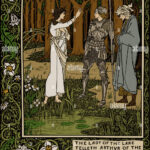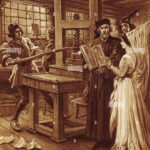15th Century English Literature – Important MCQS
The 15th century in English literature is often referred to as a “barren period” due to the lack of major literary innovation. Here are important MCQs on 15th-century English Literature. These will surely help you prepare for competitive exams like UGC NET, PGT, or university entrance tests.
I. 40 MCQS with answers on the 15th-century English Literature:
1. Who is the author of Le Morte d’Arthur?
A. Geoffrey Chaucer
B. John Lydgate
C. Thomas Malory
D. William Langland
Answer: C. Thomas Malory

2. What is Le Morte d’Arthur primarily about?
A. The Black Death in England
B. The pilgrimage to Canterbury
C. The legends of King Arthur and his knights
D. The life of King Henry V
Answer: C. The legends of King Arthur and his knights
3. Which literary form became highly popular among common people in the 15th century?
A. Sonnet
B. Epic
C. Ballad
D. Lyric
Answer: C. Ballad
4. What is the central symbol of equality in Arthur’s court?
A. The Sword in the Stone
B. Camelot
C. The Round Table
D. The Holy Grail
Answer: C. The Round Table
5. Which 15th-century literary form was used to teach moral lessons using allegorical characters?
A. Epic poetry
B. Miracle plays
C. Morality plays
D. Sonnet
Answer: C. Morality plays
6. Which knight is known for achieving the Holy Grail in Le Morte d’Arthur?
A. Sir Lancelot
B. Sir Galahad
C. Sir Gawain
D. Sir Percival
Answer: B. Sir Galahad
7. Which of the following writers was a follower of Chaucer and wrote The Fall of Princes?
A. Thomas Hoccleve
B. William Dunbar
C. John Lydgate
D. Robert Henryson
Answer: C. John Lydgate
8. What is the purpose of morality plays in 15th-century English Literature?
A. To entertain kings
B. To teach Latin grammar
C. To educate the public about Christian values
D. To retell classical myths
Answer: C. To educate the public about Christian values
9. Which famous outlaw became a popular subject of 15th-century ballads?
A. Beowulf
B. Robin Hood
C. King Lear
D. Sir Thomas More
Answer: B. Robin Hood
10. The 15th century in English literature is often described as:
A. The Age of Elizabeth
B. The Age of Satire
C. A Barren period
D. The Age of Sensibility
Answer: C. A Barren period
11. Which of the following is a morality play?
A. Everyman
B. The Canterbury Tales
C. Piers Plowman
D. The Faerie Queene
Answer: A. Everyman
12. The language of Le Morte d’Arthur is:
A. Old English
B. Middle English
C. Latin
D. Early Modern English
Answer: B. Middle English
13. Who printed Le Morte d’Arthur in 1485?
A. Richard Tottel
B. William Shakespeare
C. William Caxton
D. John Wycliffe
Answer: C. William Caxton
14. What does the Holy Grail symbolize in Malory’s narrative?
A. Royal power
B. Eternal youth
C. Earthly success
D. Spiritual purity and salvation
Answer: D. Spiritual purity and salvation
15. Which 15th-century poet is considered Chaucer’s disciple?
A. Edmund Spenser
B. Thomas Nashe
C. John Lydgate
D. Ben Jonson
Answer: C. John Lydgate
16. Which poet wrote The Testament of Cresseid?
A. John Gower
B. Robert Henryson
C. William Langland
D. John Skelton
Answer: B. Robert Henryson
17. Which knight was known for his tragic romance with Isolde?
A. Sir Gawain
B. Sir Tristram
C. Sir Gareth
D. Sir Kay
Answer: B. Sir Tristram
18. What role did William Caxton play in the development of literature?

A. He translated Latin texts into English
B. He introduced the printing press to England
C. He reformed poetic forms
D. He wrote morality plays
Answer: B. He introduced the printing press to England
19. Which of the following features is not found in a ballad?
A. Refrain
B. Complicated vocabulary
C. Simple narrative
D. Dialogue
Answer: B. Complicated vocabulary
20. “Everyman” ends with the triumph of which character?
A. Death
B. Knowledge
C. Good Deeds
D. Fellowship
Answer: C. Good Deeds
21. Sir Galahad is the son of which knight?
A. Sir Gawain
B. Sir Percival
C. Sir Lancelot
D. Sir Tristram
Answer: C. Sir Lancelot
22. In which form were ballads mainly passed down?
A. Printed form
B. Latin manuscripts
C. Oral tradition
D. Dramatic performance
Answer: C. Oral tradition
23. The Round Table promoted:
A. Military dictatorship
B. Knightly equality
C. Hierarchical order
D. Royal taxation
Answer: B. Knightly equality
24. Which literary genre was most effective in dramatizing moral conflict?
A. Elegy
B. Sonnet
C. Morality Play
D. Tragedy
Answer: C. Morality Play
25. Who is the traitor in Arthur’s court that leads to its fall?
A. Sir Lancelot
B. Sir Gawain
C. Mordred
D. Merlin
Answer: C. Mordred
26. The ballads of Robin Hood reflect which of the following?
A. Religious devotion
B. Royal propaganda
C. Popular rebellion and folk heroism
D. Greek mythology
Answer: C. Popular rebellion and folk heroism
27. What poetic device is commonly used in ballads?
A. Iambic pentameter
B. Rhyme royal
C. Refrain
D. Sestina
Answer: C. Refrain
28. The knight who most embodies spiritual purity in Malory’s work is:
A. Sir Percival
B. Sir Gawain
C. Sir Galahad
D. Sir Lancelot
Answer: C. Sir Galahad
29. Which of the following writers was active in Scotland during the 15th century?
A. Robert Henryson
B. William Langland
C. Thomas More
D. Thomas Kyd
Answer: A. Robert Henryson
30. In Everyman, who finally agrees to accompany Everyman to the grave?
A. Fellowship
B. Knowledge
C. Strength
D. Good Deeds
Answer: D. Good Deeds
II. Here are a few True / False Questions for you on the 15th-century English Literature:
-
Le Morte d’Arthur was originally written in poetic form.
False -
The Round Table promoted chivalric hierarchy.
False (It promoted equality) -
Robin Hood ballads were banned by the Church in the 15th century.
False -
Morality plays were based on Bible stories.
True -
William Caxton helped preserve English literature by printing texts.
True -
Sir Gawain achieves the Holy Grail.
False -
Ballads were usually written in complicated language.
False -
John Lydgate was a follower of Geoffrey Chaucer.
True
III. Matching (Column A with Column B) on the 15th-century English Literature:
| Column A | Column B |
|---|---|
| A. Le Morte d’Arthur | 1. Sir Thomas Malory |
| B. Everyman | 2. Morality Play |
| C. Robin Hood | 3. Folk Ballads |
| D. John Lydgate | 4. The Fall of Princes |
Answers: A–1, B–2, C–3, D–4
IV. Assertion & Reason Questions on the 15th-century English Literature:
1.
Assertion (A): Ballads gained popularity in the 15th century.
Reason (R): Ballads used simple language and were passed orally.
A. Both A and R are true, and R is the correct explanation. ✅
B. Both A and R are true, but R is not the correct explanation.
C. A is true, R is false.
D. A is false, R is true.
Answer: A
2.
Assertion (A): Morality plays disappeared after the 15th century.
Reason (R): The invention of the printing press made stage plays obsolete.
A. Both A and R are true, and R is the correct explanation.
B. A is true, R is false. ✅
C. A is false, R is true.
D. Both A and R are false.
Answer: B
Read More:
ANGLO-SAXON PERIOD: 50 MCQs WITH ANSWERS STUDY ENGLISH LITERATURE
MCQs – Middle English Period STUDY ENGLISH LITERATURE
Daddy by Sylvia Plath | Summary, Structure and Style, and Important Lines STUDY ENGLISH LITERATURE
